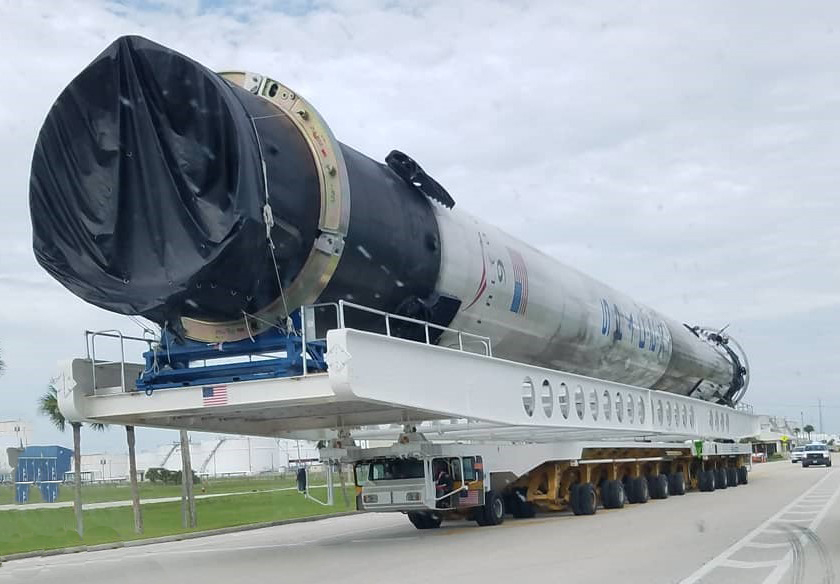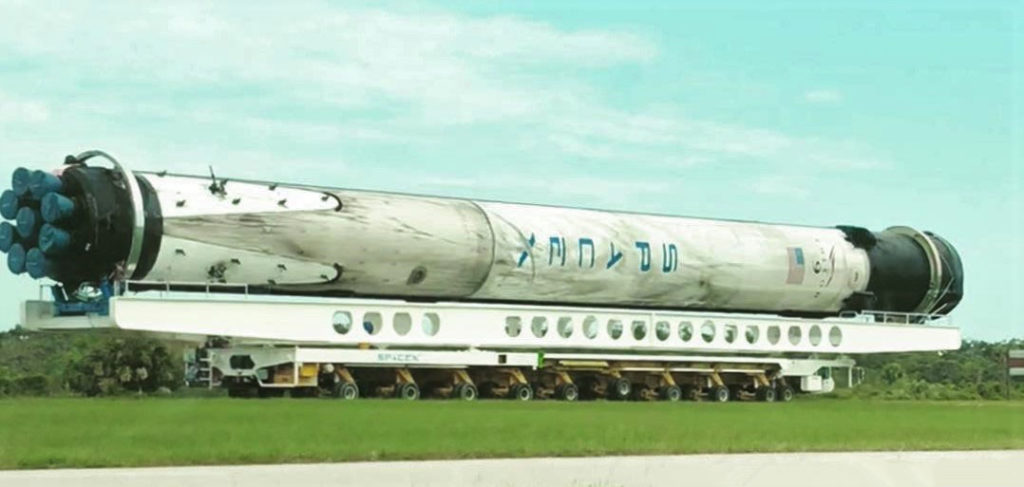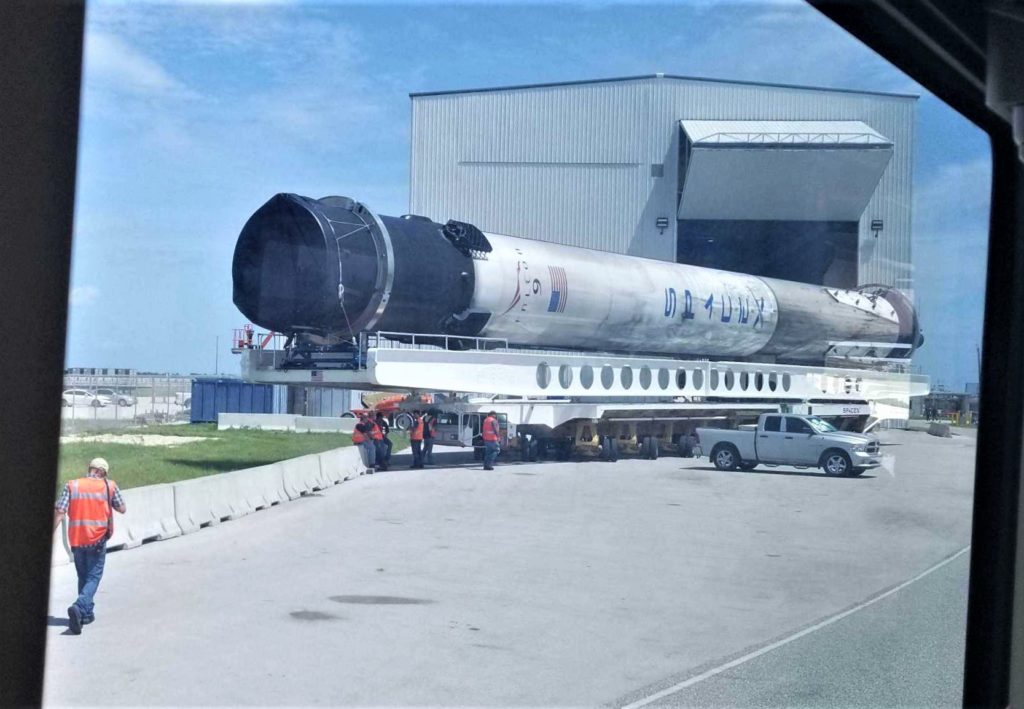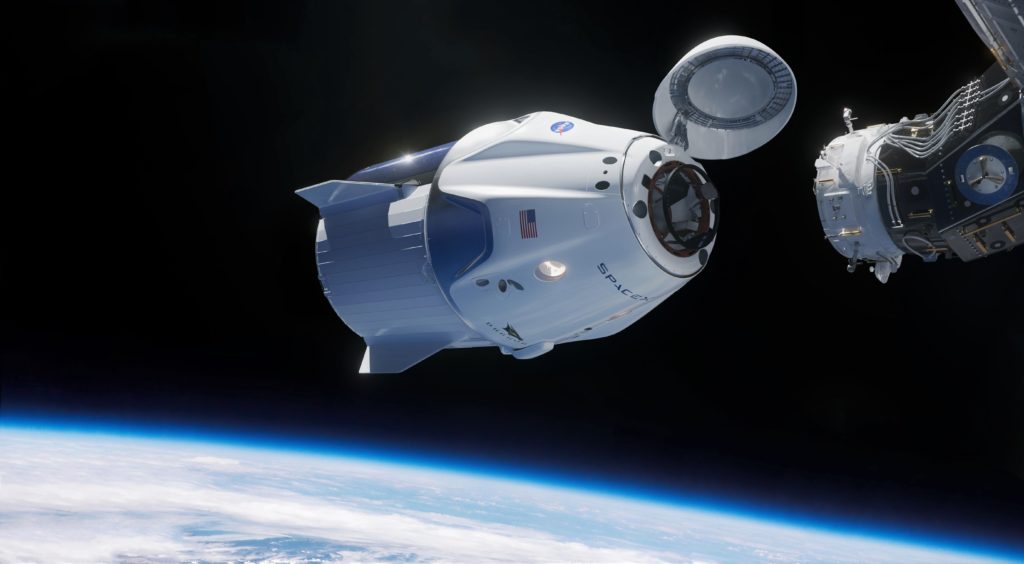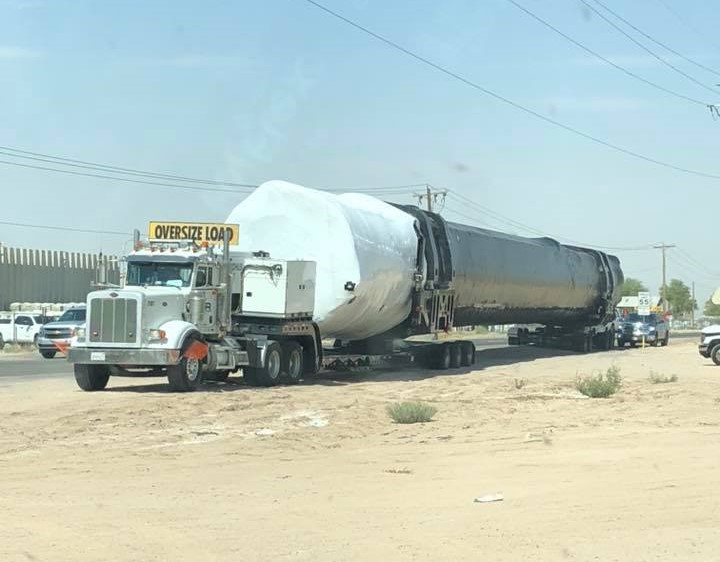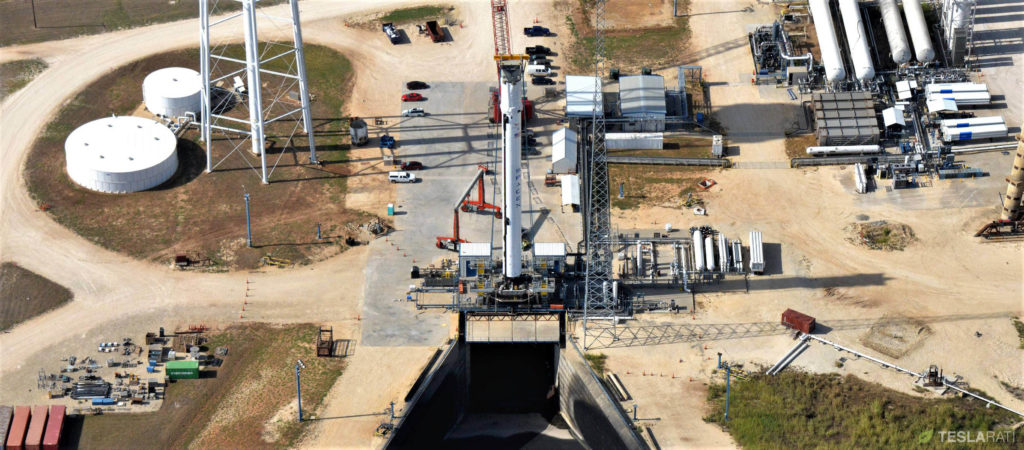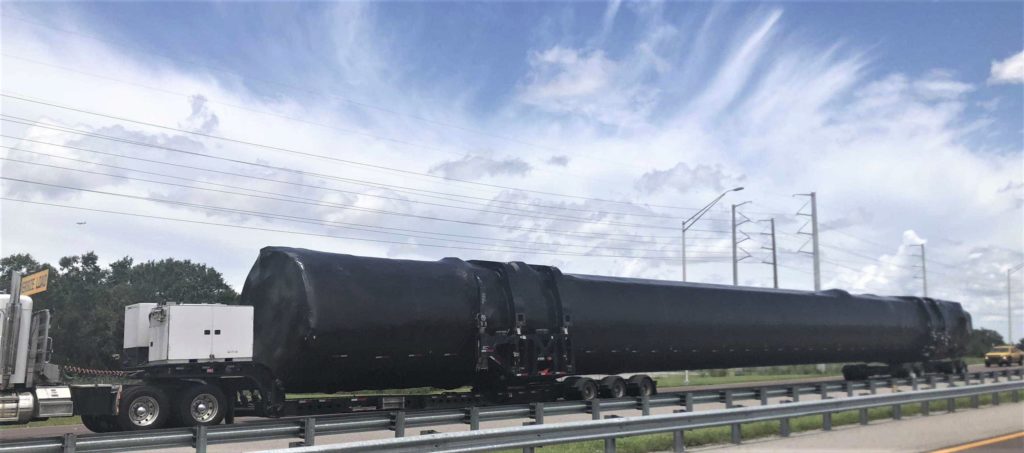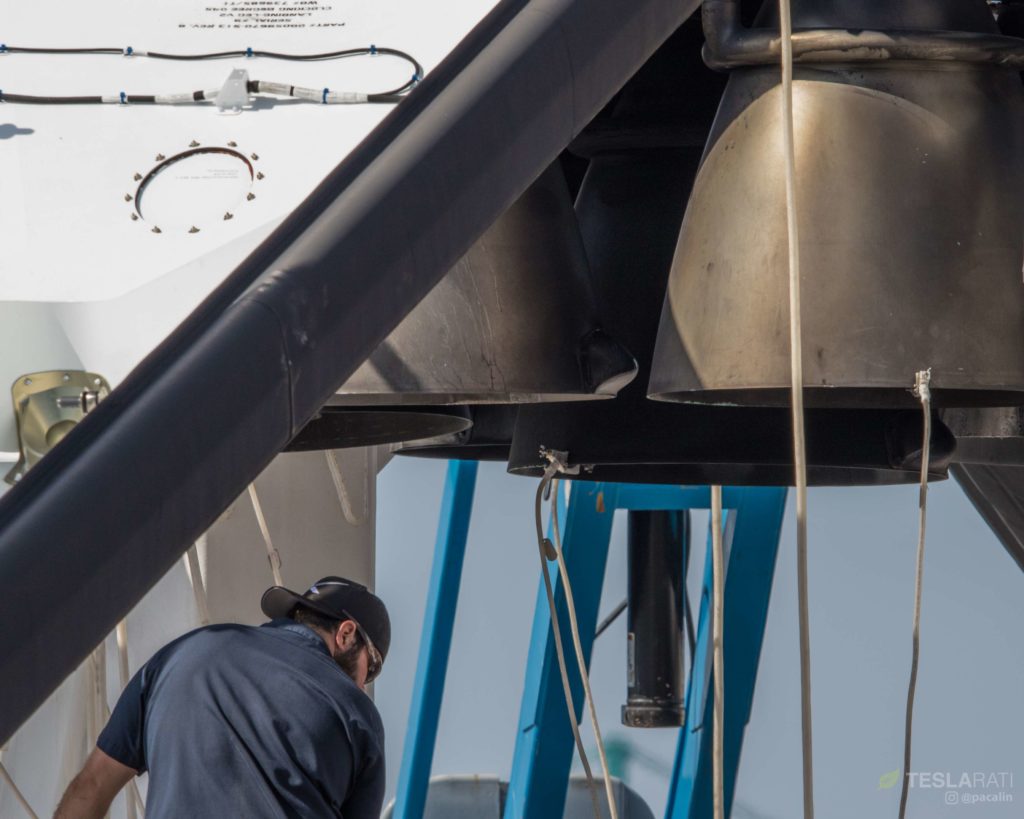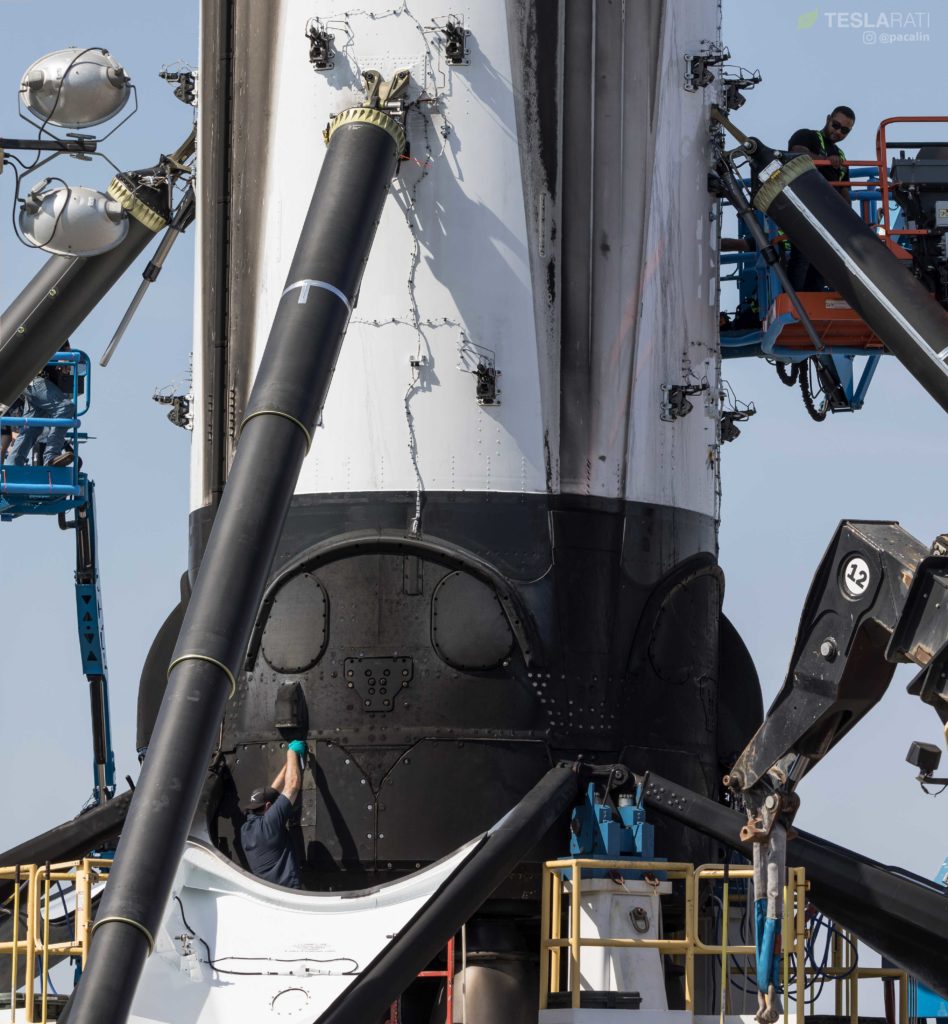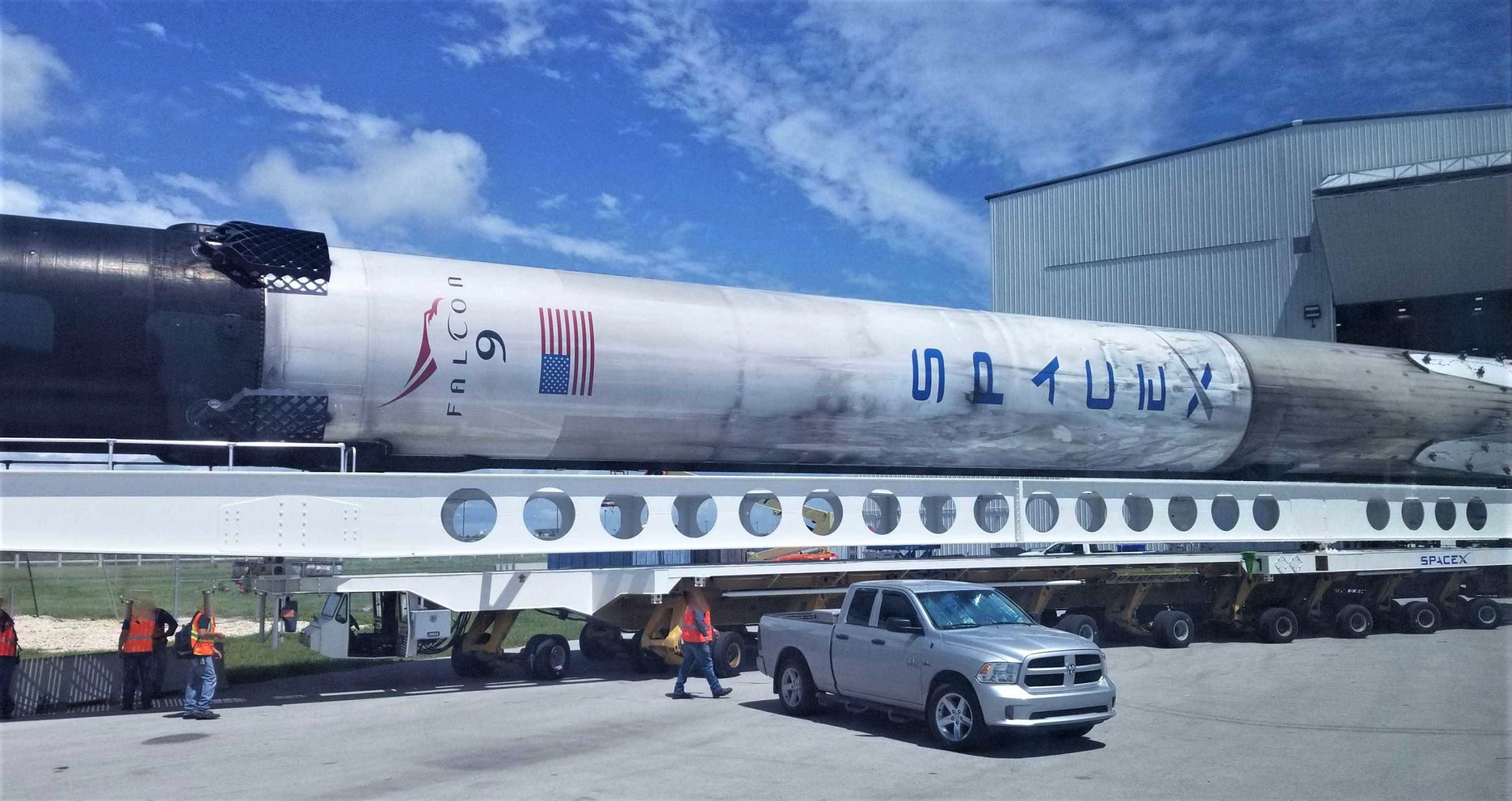
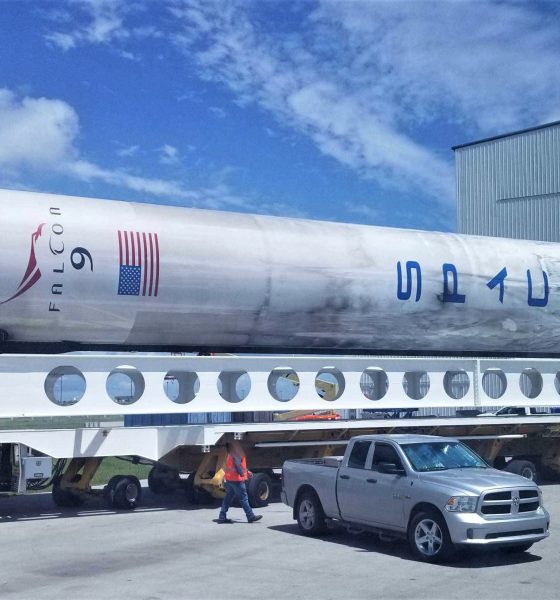
News
SpaceX’s newest Falcon 9 booster arrives in FL as rocket fleet activity rapidly grows
SpaceX’s fifth Falcon 9 Block 5 first stage was spotted a few dozen miles away from arriving at Cape Canaveral at the same time as a freshly launched and landed Block 5 booster was being transported from its drone ship at Port Canaveral to Kennedy Space Center.
The now flight-proven booster in question – B1047 – completed a successful launch of the massive 7100 kg Telstar 19V satellite on July 22nd (EDT), after which it landed safely aboard East Coast drone ship Of Course I Still Love You. Three days after that, sooty Falcon 9 B1047 arrived at Port Canaveral, where it took five days to prepare for transport to one of SpaceX’s several Floridan refurbishment facilities. That transport was captured by an impressive number of independent observers from start to finish, in this case winding up at Pad 39A’s hangar (or horizontal integration facility, HIF) for examination and refurbishment before its next launch.
- B1047 returned safe and sound to Pad 39A for refurbishment less than a week after launching and landing. (Instagram /u/d_lo_ags)
- Likely taken around the same time, Instagram /u/acslater90 took this photo from the opposite direction. (Instagram – acslater90)
- B1047 seen rolling into 39A’s integration hangar for refurbishment on July 31st. (Reddit – Kent767)
Simultaneously, multiple separate members of the subreddit /r/SpaceX observed a different Falcon 9 rocket booster being transported in Western Florida and later Orlando, this time a brand new core shrink-wrapped in the usual black plastic – fresh from static fire testing in McGregor, Texas. A photographer flying in the area in mid-July caught the most likely booster candidate (B1050) vertical on the Texas static fire test stand, rounding out a dizzying array of photos documenting SpaceX’s rigorous test and transport system in action over the last several months.
B1050 will likely be tasked with lifting communications satellite Es’hail-2 in very late August or early September. Intriguingly, the appearance of B1050 in Florida also happens to indicate that SpaceX’s next West Coast launch – SAOCOM 1A, NET September 5th – will have to launch aboard a flight-proven Block 5 booster, of which B1047 and B1048 will be up for consideration. B1051, the next new Block 5 booster expected to ship from Hawthorne to Texas to launch pad, is specifically reserved for SpaceX’s first Crew Dragon mission (DM-1), an uncrewed demo flight that could launch in October or November.
- Crew Dragon gleams in the orbital sunlight before the ISS. The spacecraft’s first launch has reserved Falcon 9 B1051, the next serial booster expected to leave SpaceX’s factory.(SpaceX)
- Falcon 9 B1050 on its way to McGregor for static fire testing, July 6th.
- SpaceX tests all new Falcon 9 boosters and upper stages in Texas before launch. (Aerial Photo/Teslarati)
- Two weeks after it was spotted on the McGregor static fire stand, B1050 rolled into Orlando, FL on July 31st, headed East to Cape Canaveral. (Reddit – alexbrock57)
It’s likely that B1051’s testing and static fire in McGregor will take much longer than the average booster acceptance testing, meaning that the facility’s Falcon 9 booster test capabilities will likely be saturated for a month or longer, pushing B1052’s commercial launch readiness into late September or early October. In reality, B1048 is the only practical option for an early or mid-September launch in California, and that tentative and unofficial booster reflight would crush the current rocket turnaround record by more than four weeks (42 days vs. 72 days).
Booster B1048 just completed its successful debut with the launch of Iridium NEXT-7 and has been under the watchful care of SpaceX recovery technicians since its July 27th return to Port of San Pedro aboard autonomous spaceport drone ship Just Read The Instructions (JRTI). Of particular note, SpaceX technicians took the extraordinary step of opening up B1048’s Merlin engine service bay panels (one per engine along the circumference of the rocket’s base) for several hours on July 30th.
As far as Falcon recoveries go, SpaceX has never been documented performing a similar procedure while the booster is still dockside – perhaps it’s related to the fact that B1050’s East Coast arrival means B1048 will have to be ready for its second launch faster than any SpaceX rocket before it.
- A SpaceX recovery technician works beneath Falcon 9 B1048’s massive octaweb and Merlin 1D engines, July 30. (Pauline Acalin)
- SpaceX technicians examine F9 B1048’s quick-disconnect panel, the interface for much of the vehicle’s fluids and on-pad communications. (Pauline Acalin, 07/30/18)
- A symphony of rocket wrenching, July 30th. (Pauline Acalin)
For prompt updates, on-the-ground perspectives, and unique glimpses of SpaceX’s rocket recovery fleet (including fairing catcher Mr Steven) check out our brand new LaunchPad and LandingZone newsletters!

News
Tesla Full Self-Driving warrants huge switch-up on essential company strategy
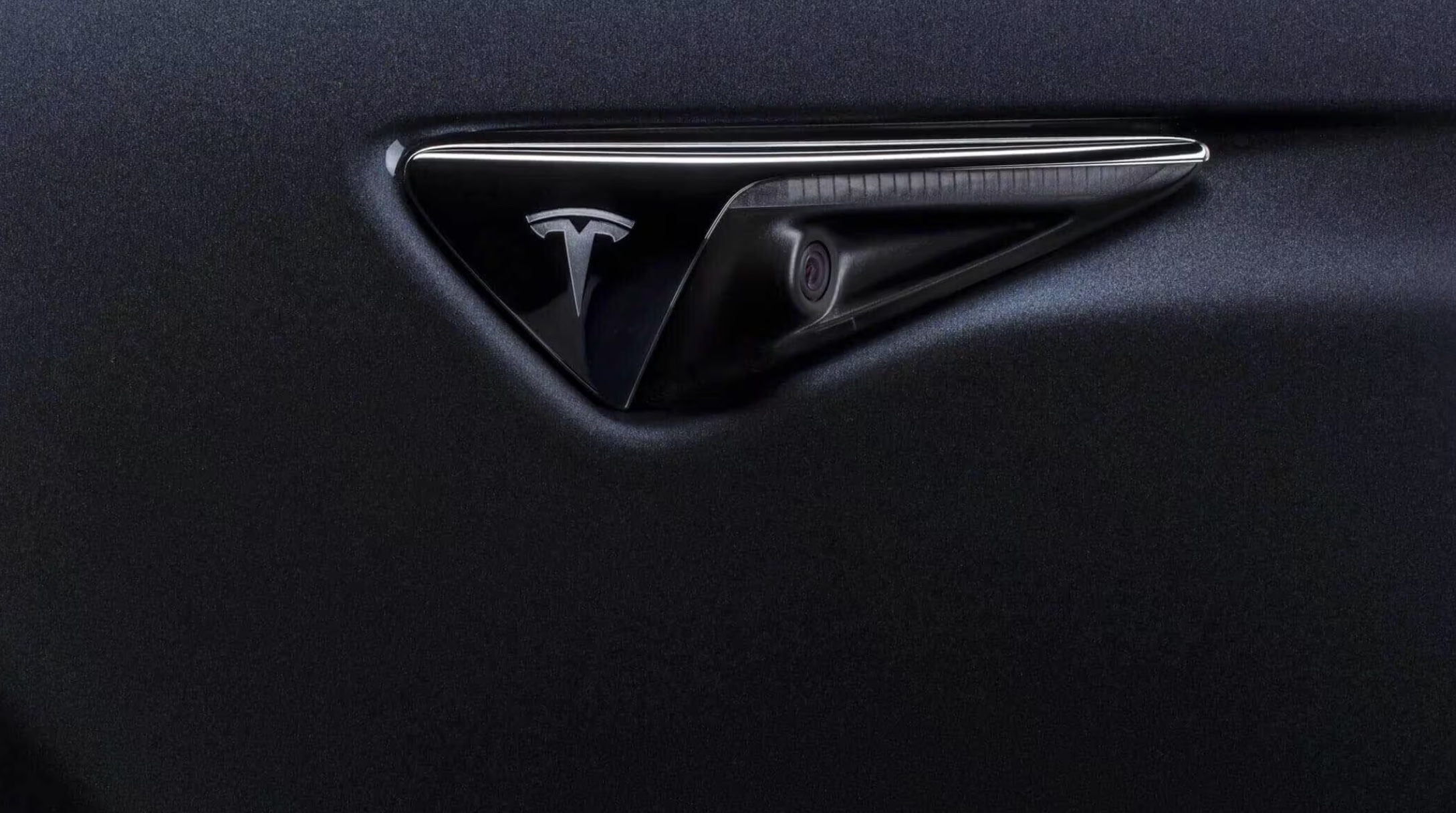
Tesla Full Self-Driving has warranted a huge switch-up on an essential company strategy as the automaker is hoping to increase the take rate of the ADAS suite.
Unlike other automotive companies, Tesla has long been an outlier, as it has famously ditched a traditional advertising strategy in favor of organic buzz, natural word-of-mouth through its production innovation, and utilizing CEO Elon Musk’s huge social media presence to push its products.
Tesla has taken the money that it would normally spend on advertising and utilized it for R&D purposes. For a long time, it yielded great results, and ironically, Tesla saw benefits from other EV makers running ads.
Tesla counters jab at lack of advertising with perfect response
However, in recent years, Tesla has decided to adjust this strategy, showing a need to expand beyond its core enthusiast base, which is large, but does not span over millions and millions as it would need to fend off global EV competitors, which have become more well-rounded and a better threat to the company.
In 2024 and 2025, Tesla started utilizing ads to spread knowledge about its products. This is continuing, as Full Self-Driving ads are now being spotted on social media platforms, most notably, X, which is owned by Musk:
NEWS: Tesla is running paid advertisements on X about FSD (Supervised). Here’s an ad they started running yesterday: pic.twitter.com/IHVywLMyTd
— Sawyer Merritt (@SawyerMerritt) November 25, 2025
Interestingly, Tesla’s strategy on FSD advertising is present in Musk’s new compensation package, as the eleventh tranche describes a goal of achieving 10 million active paid FSD subscriptions.
Full Self-Driving is truly Tesla’s primary focus moving forward, although it could be argued that it also has a special type of dedication toward its Optimus robot project. However, FSD will ultimately become the basis for the Robotaxi, which will enable autonomous ride-sharing across the globe as it is permitted in more locations.
Tesla has been adjusting its advertising strategy over the past couple of years, and it seems it is focused on more ways to spread awareness about its products. It will be interesting to see if the company will expand its spending even further, as it has yet to put on a commercial during live television.
We wouldn’t put it out of the question, at least not yet.
News
Tesla Model Y Standard: first impressions from a Premium owner
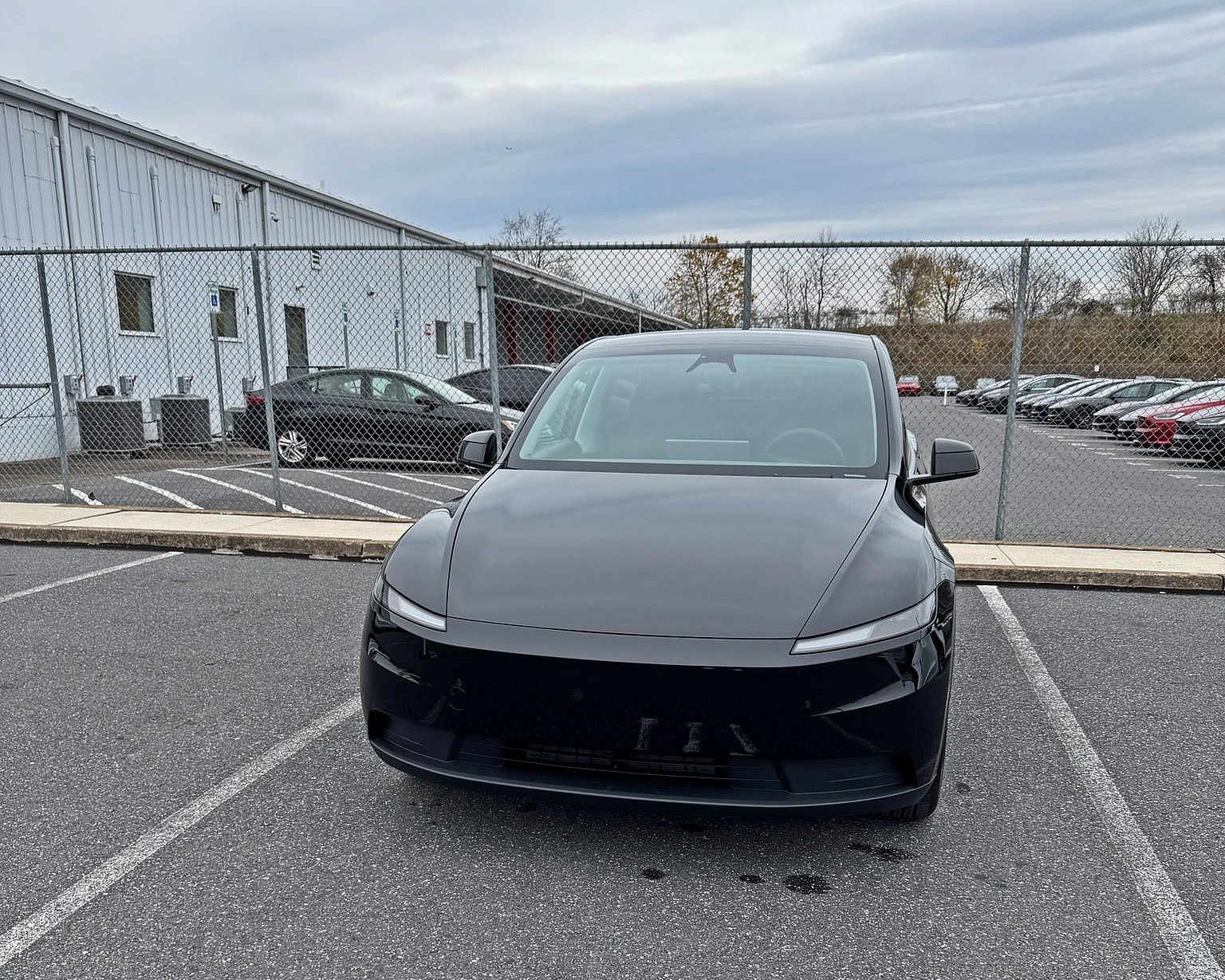
Tesla was nice enough to hook us up with the new Model Y “Standard” trim for a few days, and while we’ll be sure to fill you in on the full experience in the coming days, there are a lot of differences we noticed right off the bat, which make the ownership experience different from the “Premium” configuration level.
I purchased a Model Y Long Range All-Wheel-Drive back in August and took delivery just two weeks later. Through the first three months of owning my car, I’ve come to love so many things about the Tesla experience.
I traded my ICE vehicle for a Tesla Model Y: here’s how it went
However, I was interested in experiencing the affordable trim and seeing whether I would miss any of the voided features of the “Premium” Model Y.
Through the first 24 hours, here are my first impressions of the Model Y Standard as a Premium trim level owner:
Overall Aesthetic
The lack of a light bar is not something that is a dealbreaker. In fact, I would argue that the Model Y Standard’s more traditional headlight design is just as pleasing from an aesthetic standpoint.
The car is great looking from top to bottom; there are not a substantial number of differences besides the lack of a lightbar on both the front and the back of the car.
Overall, it is a very sleek vehicle, but the major changes are obviously with the interior.
Interior Changes
This is where the big differences are, and some of the things I’ve gotten used to in the Premium are not included. If I didn’t have a Premium Model Y already, I’m not sure I’d miss some of the things that are not present in the Standard trim, but I believe I’d get annoyed with it.
First impressions:
✅ Interior is excellent. I definitely miss the additional storage already that is available in my Premium. I could definitely get over it though
✅ Noticeable step down in sound system. Long Time by Boston absolutely cranks in the Premium; it’s still very… https://t.co/JNWvxTd8p1
— TESLARATI (@Teslarati) November 25, 2025
Storage
The Premium has a large storage compartment between the cupholders and the wireless charger, which is not present in the Standard trim. Instead, it is more like the Cybertruck, as there is a pass-through and floor storage.
I think that the pass-through is nice, but the additional storage is something I take advantage of, especially as someone who films Full Self-Driving videos, which requires hauling mounts, GoPros, and other accessories.
The sleekness of the Premium trim is also something I prefer; I really enjoy having the ability to close those compartments and cover the cupholders.
Obviously, this is a really trivial issue and not something that is substantially impactful from an ownership experience. If I weren’t already an owner, I am not sure I’d even have something to complain about.
Material Differences
The Premium trim seats are completely Vegan Leather, which I really do like, even as someone who doesn’t really love leather seats due to their temperature dependency.
The Standard trim features a Textile and Vegan hybrid, which has half of the seat a different material than the other.
The material is very similar to what I had in my previous car, a Bronco Sport. It was very durable, easy to clean, dried quickly, and hid a lot of things that leather does not, like oils from your skin, which constantly require attention to keep your interior looking fresh.
The wireless charger is also a different material, as the Premium features an Alcantara material on that. The Standard has a rubberized and textured backing, which looks good, too. They’re both more than suitable.
Other Missing Features
The Standard lacks a few minor things, most noticeably is the ambient lighting. The biggest change, however, and something I really miss, is the glass roof.
A lot of people told me that when I got my Model Y, I wouldn’t even notice the glass roof after a few weeks. That could not be further from the truth. I look out of it all the time, and it’s one of my family’s favorite parts of the car.
My Fiancè and I really love parking and watching Netflix when we pick food up, especially when it’s raining, because the glass roof gives such a great view.
We also loved it as Fall arrived, because it was great to look at the foliage.
Buy the Tesla.
Enjoy the glass roof. pic.twitter.com/r2GDyOEEWu
— TESLARATI (@Teslarati) October 28, 2025
Bigger Differences
There are also a handful of very noticeable differences from the overall cabin experience, especially with the sound system.
Much Weaker Sound System
The Model Y Standard has just 7 speakers and 1 amp, with no subwoofer. This is a significant step down from the 13-15 speakers in the Premium Long Range AWD Model Y, the 2 amps it comes with, and 1 subwoofer in the trunk.
I usually like to listen to Long Time by Boston to test out a sound system, and it was noticeably weaker in the Standard. It was missing a big portion of the umph that is provided by the Premium’s sound system.
Cabin Noise
It feels like the Cabin Noise is definitely more noticeable in the Standard, which is something I really love about my Model Y. It is able to dampen so much road noise from louder cars, and I don’t feel as if it is very quiet in the Standard.
This is perhaps the biggest make-or-break for me with this car. I truly have been spoiled by how quiet the cabin is in the Premium, and it’s due to the lack of acoustic-lined glass in the Standard.
I will be doing a more in-depth review of the Model Y Standard, especially with ride quality, later this week.
News
Tesla takes a step towards removal of Robotaxi service’s safety drivers
Tesla watchers are speculating that the implementation of in-camera data sharing could be a step towards the removal of the Robotaxi service’s safety drivers.

Tesla appears to be preparing for the eventual removal of its Robotaxi service’s safety drivers.
This was hinted at in a recent de-compile of the Robotaxi App’s version 25.11.5, which was shared on social media platform X.
In-cabin analytics
As per Tesla software tracker @Tesla_App_iOS, the latest update to the Robotaxi app featured several improvements. These include Live Screen Sharing, as well as a feature that would allow Tesla to access video and audio inside the vehicle.
According to the software tracker, a new prompt has been added to the Robotaxi App that requests user consent for enhanced in-cabin data sharing, which comprise Cabin Camera Analytics and Sound Detection Analytics. Once accepted, Tesla would be able to retrieve video and audio data from the Robotaxi’s cabin.
Video and audio sharing
A screenshot posted by the software tracker on X showed that Cabin Camera Analytics is used to improve the intelligence of features like request support. Tesla has not explained exactly how the feature will be implemented, though this might mean that the in-cabin camera may be used to view and analyze the status of passengers when remote agents are contacted.
Sound Detection Analytics is expected to be used to improve the intelligence of features like siren recognition. This suggests that Robotaxis will always be actively listening for emergency vehicle sirens to improve how the system responds to them. Tesla, however, also maintained that data collected by Robotaxis will be anonymous. In-cabin data will not be linked to users unless they are needed for a safety event or a support request.
Tesla watchers are speculating that the implementation of in-camera data sharing could be a step towards the removal of the Robotaxi service’s safety drivers. With Tesla able to access video and audio feeds from Robotaxis, after all, users can get assistance even if they are alone in the driverless vehicle.
